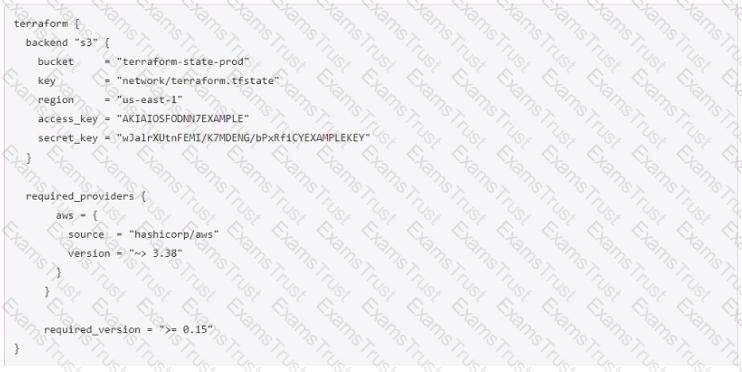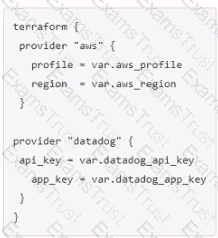Which statement describes a goal of Infrastructure as Code (IaC)?
A Terraform output that sets the "sensitive" argument to true will not store that value in the state file.
What is a key benefit of the Terraform state file?
Which of the following does terraform apply change after you approve the execution plan? (Choose two.)
What does the default "local" Terraform backend store?
You're writing a Terraform configuration that needs to read input from a local file called id_rsa.pub . Which built-in Terraform function can you use to import the file's contents as a string?
Module version is required to reference a module on the Terraform Module Registry.
How can terraform plan aid in the development process?
You can develop a custom provider to manage its resources using Terraform.
Where in your Terraform configuration do you specify a state backend?
Which of these is true about Terraform's plugin-based architecture?
Why does this backend configuration not follow best practices?

What is the name of the default file where Terraform stores the state?
Type your answer in the field provided. The text field is not case-sensitive and all variations of the correct answer are accepted.
Changing the Terraform backend from the default "local" backend to a different one after performing your first terrafom apply is:
How does Terraform determine dependencies between resources?
You have to initialize a Terraform backend before it can be configured.
You have a list of numbers that represents the number of free CPU cores on each virtual cluster:
numcpus = [ 18, 3, 7, 11, 2 ]
What Terraform function could you use to select the largest number from the list?
Which of these ate features of Terraform Cloud? Choose two correct answers.
What task does the terraform import command perform?
When do changes invoked by terraform apply take effect?
Your root module contains a variable namednum_servers. Which is the correct way to pass its value to a child module with an input namedservers?
How would you output returned values from a child module in the Terraform CLI output?
When should you run terraform init?
Which two steps are required to provision new infrastructure in the Terraform workflow?
(Pick the 2 correct responses below)
Which Terraform command checks that your configuration syntax is correct?
Which of the following ate advantages of using infrastructure as code (laC) instead of provisioning with a graphical user interface (GUI)? Choose two correct answers.
HashiCorp Configuration Language (HCL) supports user-denned functions.
Which of these ate secure options for storing secrets for connecting to a Terraform remote backend? Choose two correct answers.
Where does the Terraform local backend store its state?
You have developed a new cloud-based service that uses proprietary APIs and want to use Terraform to create, manage, and delete users from the service. How can Terraform interact with the service?
Which of the following module source paths does not specify a remote module?
terraform apply is failing with the following error. What next step should you take to determine the root cause of the problem?
Error:
yaml
CopyEdit
Error loading state: AccessDenied: Access Denied
status code: 403, request id: 288766CE5CCA24A0, host id: web.example.com
How do you specify a module’s version when publishing it to the public terraform Module Registry?
You ate creating a Terraform configuration which needs to make use of multiple providers, one for AWS and one for Datadog. Which of the following provider blocks would allow you to do this?
A)

B)
C)
D)
You can configure Terraform to log to a file using the TF_LOG environment variable.
You have a Terraform configuration that defines a single virtual machine with no references to it, You have run terraform apply to create the resource, and then removed the resource definition from your Terraform configuration file.
What will happen you run terraform apply in the working directory again?
Which of the following is not a valid Terraform collection type?
A child module can always access variables declared in its parent module.
A module block is shown in the Exhibit space of this page. When you use a module block to reference a module from the Terraform Registry such as the one in the example, how do you specify version 1.0.0 of the module?
Which task does terraform init not perform?
What type of block is used to construct a collection of nested configuration blocks?
A terraform apply can not _________ infrastructure.
Your DevOps team is currently using the local backend for your Terraform configuration. You would like to move to a remote backend to store the state file in a central location. Which of the following backends would not work?
terraform validate reports syntax check errors for which of the following?
While attempting to deploy resources into your cloud provider using Terraform, you begin to see some odd behavior and experience slow responses. In order to troubleshoot you decide to turn on Terraform debugging. Which environment variables must be configured to make Terraform's logging more verbose?
In a HCP Terraform/Terraform Cloud workspace linked to a version control repository, speculative plan runs start automatically when you merge or commit changes to version control.
If one of your modules uses a local value, you can expose that value to callers of the module by defining a Terraform output in the module’s configuration.
Terraform can only manage resource dependencies if you set them explicitly with the depends_on argument.
How does Terraform manage most dependencies between resources?
Terraform configuration can only import modules from the public registry.
You want to use API tokens and other secrets within your team's Terraform workspaces. Where does HashiCorp recommend you store these sensitive values? (Pick the 3 correct responses)
Which parameters does terraform import require? Choose two correct answers.
A provider configuration block is required in every Terraform configuration.
Example:

All modules published on the official Terraform Registry are maintained and tested by HashiCorp.
Define the purpose of state in Terraform.
Which of these are features of HCP Terraform/Terraform Cloud? Pick the 2 correct responses below.
When does Sentinel enforce policy logic during a Terraform Cloud run?
terraform validate confirms that your infrastructure matches the Terraform state file.
One cloud block always maps to a single HCP Terraform/Terraform Cloud workspace.
You are working on some new application features and you want to spin up a copy of your production deployment to perform some quick tests. In order to avoid having to configure a new state backend, what open source Terraform feature would allow you create multiple states but still be associated with your current code?
You want to define multiple data disks as nested blocks inside the resource block for a virtual machine. What Terraform feature would help you define the blocks using the values in a variable?
Which of the following command would be use to access all of the attributes and details of a resource managed by Terraform?
How does the Terraform cloud integration differ from other state backends such as S3, Consul,etc?
When should you use the force-unlock command?
What is the Terraform style convention for indenting a nesting level compared to the one above it?
You must use different Terraform commands depending on the cloud provider you use.
Terraform encrypts sensitive values stored in your state file.
Only the user that generated a plan may apply it.
Which of the following commands would you use to access all of the attributes and details of a resource managed by Terraform?
Terraform configuration can only call modules from the public registry.
Where can Terraform not load a provider from?
When should you write Terraform configuration files for existing infrastructure that you want to start managing with Terraform?
Which of the following statements about Terraform modules is not true?
How can a ticket-based system slow down infrastructure provisioning and limit the ability to scale? Choose two correct answers.
When you use a remote backend that needs authentication, HashiCorp recommends that you: